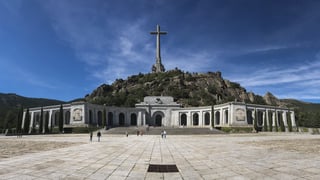
The Valley of the Fallen (Spanish: Valle de los Caídos; Spanish pronunciation: [ˈbaʎe ðe los kaˈiðos]) is the former name of site now known officially as the Valle de Cuelgamuros in the Sierra de Guadarrama, near Madrid, Erected at Cuelgamuros Valley, it comprises a Catholic basilica and a monumental memorial in the municipality of San Lorenzo de El Escorial. Dictator Francisco Franco claimed that the monument was meant to be a "national act of atonement" and reconciliation. Although it appears that Franco did not specifically intend to be buried there, it served as his burial place from his death in November 1975 until his exhumation on 24 October 2019, as a result of efforts to remove all public veneration of his dictatorship, and following a long and controversial legal process. The monument, considered a landmark of 20th-century Spanish architecture, was designed by Pedro Muguruza and Diego Méndez on a scale to equal, according to Franco, "the grandeur of the monuments of old, which defy time and memory." Together with the Universidad Laboral de Gijón, it is the most prominent example of the original Spanish Neo-Herrerian style, which was intended to form part of a revival of Juan de Herrera's architecture, exemplified by the nearby royal residence El Escorial. This uniquely Spanish architecture was widely used in public buildings of post-war Spain and is rooted in international fascist classicism as exemplified by Albert Speer or Mussolini's Esposizione Universale Roma. The monument precinct covers over 3,360 acres (13.6 km2) of Mediterranean woodlands and granite boulders on the Sierra de Guadarrama hills, more than 3,000 feet (910 m) above sea level and includes a basilica, a Benedictine abbey, a guest house, the Valley, and the Juanelos — four cylindrical monoliths dating from the 16th century. The most prominent feature of the monument is the towering 150-metre-high (500 ft) Christian cross, the tallest such cross in the world, erected over a granite outcrop 150 metres over the basilica esplanade and visible from over 20 miles (32 km) away. Work started in 1940 and took over eighteen years to complete, with the monument being officially inaugurated on 1 April 1959. According to the official ledger, the cost of the construction totalled 1,159 million pesetas, funded through national lottery draws and donations. Some of the labourers were prisoners who traded their labour for a reduction in time served. The complex is owned and operated by the Patrimonio Nacional, the Spanish governmental heritage agency, and ranked as the third most visited monument of the Patrimonio Nacional in 2009. The Spanish social democrat government closed the complex to visitors at the end of 2009, citing safety reasons connected to restoration on the façade. The decision was controversial, as the closure was attributed by some people to the Historical Memory Law enacted during José Luis Rodríguez Zapatero's premiership, and there were claims that the Benedictine community was being persecuted. The works[clarification needed] include the Pietà sculpture prominently featured at the entrance of the crypt, using hammers and heavy machinery. From Wikipedia

